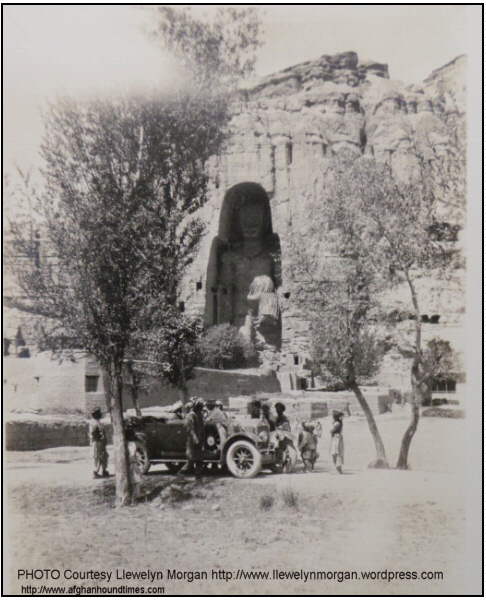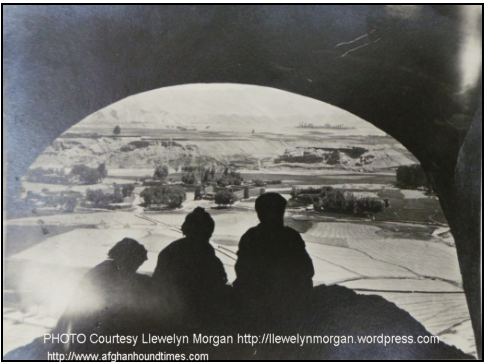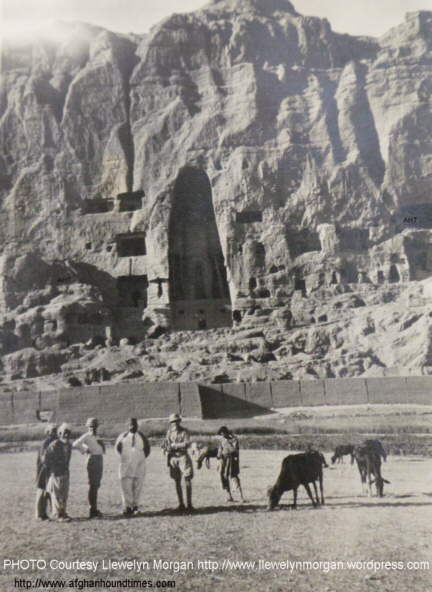Lieut-Colonel L.W. Amps and Mrs Mary Amps Page2
"Nice Buddha; nice set of wheels"
By Llewellyn Morgan (Oxford, England)
(http://llewelynmorgan.wordpress.com)
Llewelyn Morgan is a scholarly researcher located in Oxford, England. Llewlyn's "about page" summarizes his research interests as follows - "I'm a Classicist, lucky enough to work at Brasenose College, Oxford. I specialise in Roman literature, but I've got a persistent side-interest in Afghanistan, particularly the scholars and spies and scholar-spies who visited the country in the nineteenth century. , mainly Roman, and mainly Roman poetry, with a side interest in Afghanistan and vicinity, especially in the nineteenth century. Author of Musa Pedestris on Roman poetry, and The Buddhas of Bamiyan on Afghanistan".
AHT Ed Note; Lyall Payne located the article below, authored by Llewelyn Morgan and posted on his website (http://llewelynmorgan.wordpress.com). Llewelyn has very kindly given his permission for AHT to reproduce his article which includes references to, and a photograph of, Mary and Major Amps in Afghanistan in 1929. These photographs of the Amps most likely have never been seen by the breed before. We are indebted to Llewelyn for his article and for his kind permission to reprint it here.
I (Llewelyn) hope you’ll agree this is a pretty evocative photo:
Group of Visitors at Bamiyan, Afg. 1929 |
Thanks to Dilek Tas, for finding it (and three other photos of Bamiyan) among the papers of Aurel Stein, the great archaeologist of Central Asia (in a box of photos sent to him in letters); and when she found it, bless her, for thinking of me.
Of course, the moment I clapped eyes on it I wanted to identify the car-owner and the date. The place was clear enough: Bamiyan, Afghanistan: in the background the larger, 55-metre Buddha, carved out of the sandstone cliff face, somehow set off so effectively by the stylish motor in the foreground.
I had a hunch the best evidence would be found inside that box of photos, but over the weekend I tried to get what I could from the photograph itself. First the car: from Bozi Mohacek, with his encyclopaedic knowledge of classic cars, I learned that this was a British make (he could tell from the position of the headlights), a Wolseley tourer of about 1926 (“Earlier possible, later by a tiny bit but unlikely. No tiebar on the lights”). Two of the other photos offered a little help, as well. One was a view from the top of the 55-metre Buddha, with the silhouettes of local people sitting on the Buddha’s head:
View from the top of the 55-metre Buddha |
This offers a small clue in itself, since the head of this larger Buddha had been inaccessible for many centuries, and it was only with the construction of a path along the cliff face by the French archaeologist André Godard, in 1923, that it was possible to reach it. So another terminus post quem. Finally, in this photo in front of the smaller, 38-metre Buddha my first thought was that the European figure on the left, in the white shirt, was a woman:
Mary Amps (3rd from left) Pat Amps (5th from Left) Bamiyan, Afg. 1929 |
Yesterday morning I finally got to look at the box of photos. There I found a slip of paper with a bare indication of the sources of the photographs Stein had collected. For these three photos, plus a fourth of the 38-metre Buddha, the provenance was a succinct “Amps, 1929?. The photos had come to Stein in a letter from Amps, in other words, but who on earth was Amps? A quick consultation of the Handbook to the Collections of Sir Aurel Stein in the UK told me no letters between Stein and Amps have survived, and none of my biographies of Aurel Stein mentioned an Amps either.
Like the world-class researcher I am, I resorted to Google: “Amps, Afghanistan.”
I got dogs, loads of them. It turns out that one Mary Amps was a very big noise indeed in Afghan Hound breeding, importing the animals from Afghanistan and running her highly successful “Ghazni kennels” at Penn near Wolverhampton. Most of the Afghan Hounds around today seem to be descended from hers. Go here (a link in the article to AHT website), and you will start to discover the interesting world of Afghan Hounds, and find lots of articles by Mrs Amps advertising her kennels with picturesque detail of her collecting trips in Afghanistan. What had taken Mary Amps to Afghanistan in the first place was her husband’s attachment to the British Legation in Kabul, effectively the embassy. Major Leon Williamson Amps was an officer of the Royal Engineers, posted to Kabul through the 1920s, a particularly volatile period in Afghan history between the Third Anglo-Afghan War of 1919 and the overthrow of the modernizing King Amanullah in 1929. I don’t at the moment know whether Leon or Mary were among those rescued in what is considered the first major airlift, the rescue in 1929 of foreigners from Kabul when it was in the grip of the revolt against Amanullah.
So we’ve identified the two Europeans in the photos, Major and Mrs Amps, travelling around Afghanistan to see the sites, but also presumably to scout out any promising looking canine bloodstock. I can’t spot any dogs in the photos, disappointingly. The pictures must date to somewhere between 1926 and the time of the letter to Aurel Stein (and the departure of all the British from Afghanistan), 1929. It all looks very jolly in these photos, but we shouldn’t be in any doubt how adventurous you had to be, as a foreigner, to travel around 1920s Afghanistan, and for that matter how uncomfortable a trip into the Hindu Kush would have been on 1920s suspension.
Mary Amps’ business thrived, as we know, and Major Amps rose to be Major-General, honoured for his work building the British Legation compound in Kabul. He died in 1989, at the respectable age of 97.
I’m pleased I’ve identified the owners of the Wolseley tourer, but Aurel Stein is where this started, and I think his reasons for preserving (perhaps even requesting) these images of Bamiyan are worth a final thought, too.
Aurel Stein travelled all over Central Asia, and in the process transformed our understanding of that space where India, China and the West encountered each other. But it’s true to say that what drove this irrepressibly energetic man more than anything else, as he himself candidly admitted, was the intense fascination he had felt since boyhood for the Greek colonisation of what are now Afghanistan and Pakistan during and after Alexander the Great’s campaigns. At the heart of this Greek “presence” in central Asia was Bactria, the territory around Balkh in northern Afghanistan where Stein expected that rich evidence would be found of the meeting of East and West, and the Buddhist cultures that emerged from it. As for Bamiyan, it was generally believed at the time, and Stein shared the belief, that the giant Buddhas and cave temples were also connected to this Greek moment in Afghan history. We now know that the Buddhas are much later than Stein and his contemporaries assumed, and not in any significant way Greek in inspiration, but for Stein Bamiyan was part and parcel of his Bactrian Eldorado, and it was one of the places he tried again and again to get official permission to visit.
But throughout his long and remarkable career, that one burning desire to visit Afghanistan was constantly denied to Stein. The Afghans were determined to “twist the lion’s tail,” make things as difficult as possible for the British, and given the history of relations between the two countries, it’s hard to blame them. In 1902, 1912 and 1919-22 Stein made concerted efforts to persuade the Afghan authorities to let him visit, but each time his request was refused. Finally, in 1943, permission for him to visit the country was granted, but the eighty-year-old Stein caught cold in the famous National Museum in Kabul, and died just a week after arriving. His grave is in the British Cemetery in Kabul.
Shortly before he died, Stein told a friend, “I have had a wonderful life, and it could not be concluded more happily than in Afghanistan, which I have wanted to visit for sixty years.”
I just wonder about Aurel Stein’s thoughts, a decade earlier, as he pondered Major and Mrs Amps’ vivid photographs of a place he just could not seem to get to, no matter how desperately he wanted to.
Copyright Llewelyn Morgan September 23 2013
See also
Ghazni Afghan Hounds Section. Steve Tillotson 2013
Lieut-Colonel L.W. Amps and Mrs Mary Amps By Steve Tillotson and Lyall Payne Nov 2013
Lt. Amps and Mary Amps "Nice Buddha; nice set of wheels" By Llewellyn Morgan (Oxford, England Sep 2013
The Hound In Afghanistan, Mary Amps, 1932
The Land Of The Afghan Hound, Mary Amps, 1930
Mrs Amps and her famous Afghan Hounds By Phyllis Robson 1930
Robert Leighton on Mrs Amps Ghazni 1926
Afghan Hounds In India, Steve Tillotson, 2012
Afghan Controversy What is the correct type? Amps and Bell Murray
Bill Hall Meeting/Interview with Major-Genl Amps 1970's
Susan (Sirdar of Ghazni daughter)- Identity Revealed. Lyall Payne and Steve Tillotson Sept 2015
Early Afghan Hounds Section
The Origins Section
GoTo Whats New
Library Of Articles/Main Menu Toolbar
|


